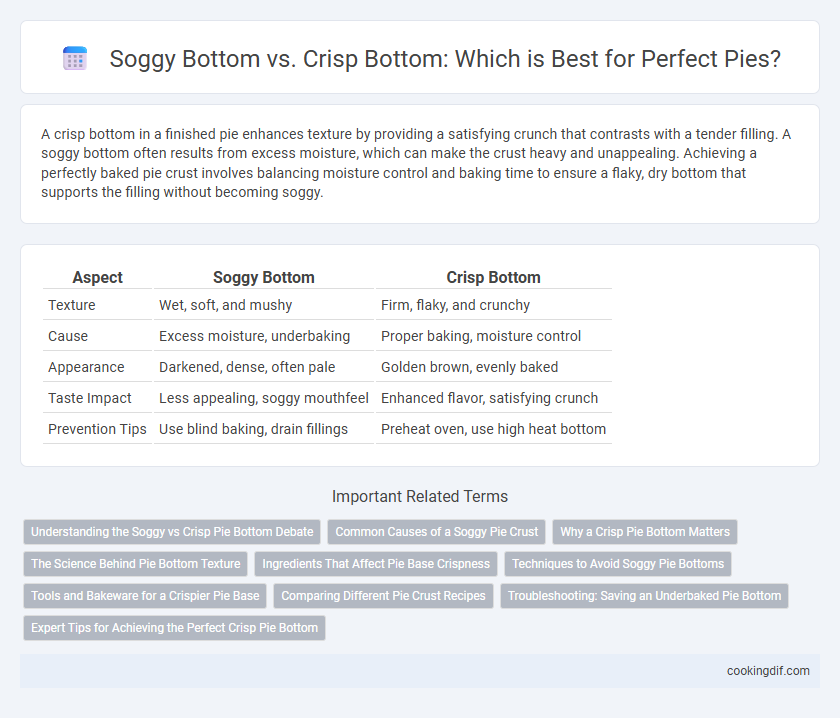A crisp bottom in a finished pie enhances texture by providing a satisfying crunch that contrasts with a tender filling. A soggy bottom often results from excess moisture, which can make the crust heavy and unappealing. Achieving a perfectly baked pie crust involves balancing moisture control and baking time to ensure a flaky, dry bottom that supports the filling without becoming soggy.
Table of Comparison
| Aspect | Soggy Bottom | Crisp Bottom |
|---|---|---|
| Texture | Wet, soft, and mushy | Firm, flaky, and crunchy |
| Cause | Excess moisture, underbaking | Proper baking, moisture control |
| Appearance | Darkened, dense, often pale | Golden brown, evenly baked |
| Taste Impact | Less appealing, soggy mouthfeel | Enhanced flavor, satisfying crunch |
| Prevention Tips | Use blind baking, drain fillings | Preheat oven, use high heat bottom |
Understanding the Soggy vs Crisp Pie Bottom Debate
Achieving the ideal pie bottom involves balancing moisture and heat to prevent sogginess while ensuring a crisp texture. Factors such as blind baking, filling moisture content, and oven temperature significantly influence crust texture. Understanding these variables helps pie makers choose techniques that yield either a soggy bottom for a softer bite or a crisp bottom for a firm, flaky finish.
Common Causes of a Soggy Pie Crust
A soggy pie crust often results from excess moisture in the filling, insufficient blind baking, or improper oven temperature. Using a hot oven and pre-baking the crust helps create a barrier that prevents moisture absorption, while ingredients like cornstarch or tapioca in the filling can thicken juices and reduce sogginess. Avoiding undercooked pie shells and draining wet fillings thoroughly ensures a crisp, flaky bottom crust.
Why a Crisp Pie Bottom Matters
A crisp pie bottom prevents sogginess by creating a barrier that keeps moisture from fruits or fillings from seeping into the crust, ensuring a firm, flaky texture. Achieving this involves techniques like blind baking and using ingredients such as egg wash or cornstarch to seal the dough and absorb excess moisture. A crisp bottom enhances the overall enjoyment of the pie by balancing texture and maintaining structural integrity during slicing and serving.
The Science Behind Pie Bottom Texture
The science behind pie bottom texture hinges on the balance between moisture and heat transfer during baking. A soggy bottom forms when steam from the filling fails to evaporate quickly, saturating the crust, while a crisp bottom results from high oven temperatures that promote rapid moisture evaporation and Maillard reaction browning. Factors such as crust thickness, fat content, and pre-baking techniques directly influence whether the pie achieves a tender soggy base or a perfectly crisp bottom.
Ingredients That Affect Pie Base Crispness
The crispness of a pie base largely depends on the type of fat used, with butter and shortening providing flakier, crisper crusts due to their higher fat content and lower water ratio. The amount of moisture in the dough is crucial; excessive liquid from ingredients like eggs or water can lead to a soggy bottom by preventing the crust from fully baking and becoming crisp. Using finer flour and pre-baking (blind baking) the crust can enhance the base's texture by allowing steam to escape and creating a barrier to moisture from the filling.
Techniques to Avoid Soggy Pie Bottoms
Achieving a crisp pie bottom requires techniques like blind baking the crust before adding fillings to prevent moisture absorption. Using a metal or glass pie dish enhances heat conduction, promoting even baking and a golden crust. Incorporating ingredients such as egg wash or sprinkling crushed nuts can create a moisture barrier that stops sogginess and ensures the perfect pie texture.
Tools and Bakeware for a Crispier Pie Base
Using a metal pie pan or a ceramic pie dish with good heat conduction can significantly improve the crispiness of the pie bottom. Incorporating a baking sheet or a pizza stone underneath the pie allows for even heat distribution, preventing sogginess by promoting moisture evaporation. Tools like a pie shield or foil strips protect edges from burning while maintaining overall bake quality, resulting in a perfectly crisp pie base.
Comparing Different Pie Crust Recipes
Comparing different pie crust recipes reveals that a soggy bottom often results from underbaked fillings or excessive moisture, while a crisp bottom is achieved through techniques like blind baking and using ingredients such as butter or shortening for flakiness. Using pie dough with a higher fat-to-flour ratio and incorporating cornstarch or flour in the filling can reduce sogginess. Recipes emphasizing cold butter and minimal water often produce the desired crisp bottom crucial for fruit, custard, and savory pies.
Troubleshooting: Saving an Underbaked Pie Bottom
A soggy pie bottom often results from insufficient baking time or excess filling moisture, while a crisp bottom indicates thorough baking and proper crust preparation. To save an underbaked pie bottom, increase oven temperature slightly and bake without the filling for 5-10 minutes, or use a baking sheet beneath the pie to improve heat conduction. Applying a thin layer of egg wash or blind baking with pie weights before adding filling also helps prevent sogginess and ensures a crisp finish.
Expert Tips for Achieving the Perfect Crisp Pie Bottom
Achieving the perfect crisp pie bottom starts with using a preheated baking sheet or ceramic pie dish to ensure even heat distribution, preventing sogginess caused by damp fillings. Expert tips include blind baking the crust with pie weights to create a barrier, and brushing the crust with egg wash or melted butter for a golden, crisp finish. Using high-quality flour with a higher protein content and avoiding overly moist fillings also helps maintain a flaky, crisp texture under the pie's filling.
Soggy bottom vs crisp bottom for finished pies Infographic

 cookingdif.com
cookingdif.com